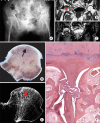Subchondral insufficiency fractures of the femoral head
- PMID: 22949947
- PMCID: PMC3425646
- DOI: 10.4055/cios.2012.4.3.173
Subchondral insufficiency fractures of the femoral head
Abstract
A subchondral insufficiency fracture (SIF) of the femoral head is a recently proposed concept, which needs to be differentiated from osteonecrosis. Clinically, SIF has generally been observed in the osteoporotic elderly women or renal transplant recipients. Radiographical changes are not obvious in its early phase, however, some cases undergo subchondral collapse (crescent sign). On the T1-weighted magnetic resonance images, a low intensity band is one of the characteristic imaging appearances, which corresponds histologically to the fracture line and associated fracture repair tissue. Therefore, the shape of the low intensity band generally tends to be irregular, disconnected, and convex to the articular surface. The prognosis of SIF is not clearly established. Some cases show resolution of the symptoms by the conservative treatments, while other cases show rapid progression of the collapse such as rapidly progressive arthrosis of the hip.
Keywords: Femoral head; Osteonecrosis; Osteoporosis; Subchondral insufficiency fracture.
Conflict of interest statement
No potential conflict of interest relevant to this article was reported.
Figures






References
-
- Yamamoto T, Iwamoto Y, Schneider R, Bullough PG. Histopathological prevalence of subchondral insufficiency fracture of the femoral head. Ann Rheum Dis. 2008;67(2):150–153. - PubMed
-
- Yamamoto T, Bullough PG. Subchondral insufficiency fracture of the femoral head: a differential diagnosis in acute onset of coxarthrosis in the elderly. Arthritis Rheum. 1999;42(12):2719–2723. - PubMed
-
- Pentecost RL, Murray RA, Brindley HH. Fatigue, insufficiency, and pathologic fractures. JAMA. 1964;187:1001–1004. - PubMed
-
- Bangil M, Soubrier M, Dubost JJ, et al. Subchondral insufficiency fracture of the femoral head. Rev Rhum Engl Ed. 1996;63(11):859–861. - PubMed
-
- Cummings SR, Rubin SM, Black D. The future of hip fractures in the United States: numbers, costs, and potential effects of postmenopausal estrogen. Clin Orthop Relat Res. 1990;(252):163–166. - PubMed
Publication types
MeSH terms
LinkOut - more resources
Full Text Sources
Medical

